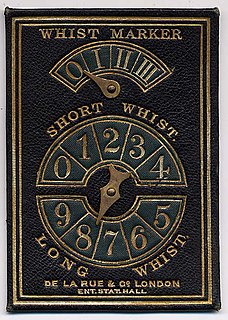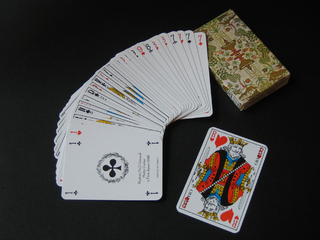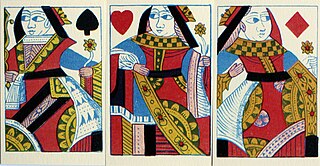Related Research Articles

Contract bridge, or simply bridge, is a trick-taking card game using a standard 52-card deck. In its basic format, it is played by four players in two competing partnerships, with partners sitting opposite each other around a table. Millions of people play bridge worldwide in clubs, tournaments, online and with friends at home, making it one of the world's most popular card games, particularly among seniors. The World Bridge Federation (WBF) is the governing body for international competitive bridge, with numerous other bodies governing it at the regional level.

Whist is a classic English trick-taking card game which was widely played in the 18th and 19th centuries. Although the rules are simple, there is scope for strategic play.
In the card game contract bridge, the Losing-Trick Count (LTC) is a method of hand evaluation that is generally only considered suitable to be used in situations where a trump suit has been established and when shape and fit are more significant than high card points (HCP) in determining the optimum level of the contract. The method is generally not considered suitable for no trump or misfit hands; also, the trump suit is generally considered to require at least eight cards in length with no partner holding fewer than three.
In contract bridge and similar games, a finesse is a type of card play technique which will enable a player to win an additional trick or tricks should there be a favorable position of one or more cards in the hands of the opponents.

Spades is a trick-taking card game devised in the United States in the 1930s. It can be played as either a partnership or solo/"cutthroat" game. The object is to take the number of tricks that were bid before play of the hand began. Spades is a descendant of the Whist family of card games, which also includes Bridge, Hearts, and Oh Hell. Its major difference as compared to other Whist variants is that, instead of trump being decided by the highest bidder or at random, the Spade suit always trumps, hence the name.
In the card game of contract bridge, to hold up means to play low to a trick led by the opponents, losing it intentionally in order to sever their communication. The primary purpose is to give as many tricks to opponents as needed to exhaust all the cards in the suit from one of their hands. If that hand regains the lead, it will not be able to put the partner on lead to cash its tricks. Hold up is one of basic techniques in play.
A (bridge) signal is a move in the card game of contract bridge in which partners defending against a contract play particular cards in a manner which gives a coded meaning or signal to guide their subsequent card play. This may also be referred to as carding. Signals are usually given with the cards from the two-spot to the nine-spot. There are three types of signals:
In trick-taking games, to ruff means to play a trump card to a trick. According to the rules of most games, a player must have no cards left in the suit led in order to ruff. Since the other players are constrained to follow suit if they can, even a low trump can win a trick. In some games, like Pinochle and Preferans, the player who cannot follow suit is required to ruff. In others, like Bridge and Whist, he may instead discard. Normally, ruffing will win a trick. But it is also possible that a subsequent player will overruff. This is not always a bad thing—see uppercut below.
In contract bridge, coup is a generic name for various techniques in play, denoting a specific pattern in the lie and the play of cards; it is a special play maneuver by declarer.
In contract bridge, the trump squeeze is a variant of the simple squeeze in which one threat is a suit that if unguarded can be established by ruffing.

Bid whist is a partnership trick-taking variant of the classic card game whist. As indicated by the name, bid whist adds a bidding element to the game that is not present in classic whist. Bid whist, along with spades, remains popular particularly in U.S. military culture and a tradition in African-American culture.
The trump coup is a contract bridge coup used when the hand on lead has no trumps remaining, while the next hand in rotation has only trumps, including a high one that would have been onside for a direct finesse if a trump could have been led. The play involves forcing that hand to ruff, only to be overruffed. A similar motive is met in coup en passant, where indirect finesse is used instead of direct.
These terms are used in contract bridge, using duplicate or rubber scoring. Some of them are also used in whist, bid whist, the obsolete game auction bridge, and other trick-taking games. This glossary supplements the Glossary of card game terms.
The Bath coup is a coup in the game of contract bridge in which the declarer, who holds AJx(x) in a suit, ducks the left-hand opponent's lead of a king in that suit. The coup is presumed to be named after the city of Bath in England and dates from the game of whist, the predecessor of bridge.
In contract bridge, various bidding systems have been devised to enable partners to describe their hands to each other so that they may reach the optimum contract. Key to this process is that players evaluate and re-evaluate the trick-taking potential of their hands as the auction proceeds and additional information about partner's hand and the opponent's hands becomes available.
In the card game contract bridge, a suit combination is a specific subset of the cards of one suit held respectively in declarer's and dummy's hands at the onset of play. While the ranks of the remaining cards held by the defenders can be deduced precisely, their location is unknown. Optimum suit combination play allows for all possible lies of the cards held by the defenders.
In the card game of bridge, tempo is the timing advantage of being on lead, thus being first to initiate one's play strategy to develop tricks for one's side. Tempo also refers to the speed of play and more generally the rhythm of play over several tricks.

Manille is a Catalan French trick-taking card game which uses a 32 card deck. It spread to the rest of France in the early 20th century, but was subsequently checked and reversed by the expansion of Belote. It is still popular in France and the western part of Belgium.

The following is a glossary of terms used in card games. Besides the terms listed here, there are thousands of common and uncommon slang terms. Terms in this glossary should not be game-specific, but apply to a wide range of card games. For glossaries that relate primarily to one game or family of similar games, see Game-specific glossaries.

Gleek is an English card game for three persons. It is played with a 44-card pack and was popular from the 16th century through the 18th century.
References
- ↑ Shorter Oxford Dictionary (2002), New York: (Oxford University Press). Volume 2. Page 2630.
- ↑ Grant, Audrey; Rodwell, Eric (1987). Bridge Maxims: Secrets of Better Play. Prentice-Hall Canada. ISBN 978-0-13-081936-9.
- ↑ Published among other places in English Bridge, June 2006, page 19